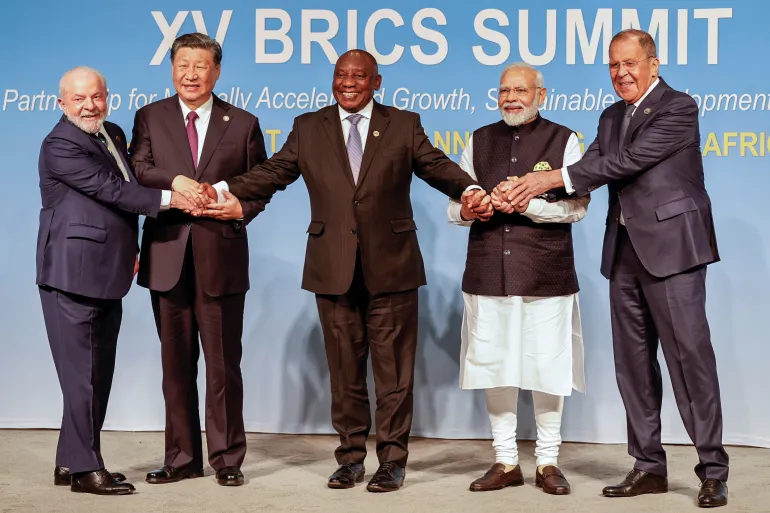Johannesburg, South Africa, August 29: The BRICS Summit 2023 in Johannesburg, South Africa marked a pivotal moment as six new members were announced to join BRICS in 2024, solidifying its role as a counterforce to the Western-dominated global order in the 21st century. The expansion highlighted the growing competition between India and China for dominance within BRICS and the leadership position of the Global South.
As BRICS emerged as a champion of the Global South, Two Indo-Pacific powers hold competing visions for the future of the grouping and the Global South.
China aims to shape BRICS into an “anti-West” alliance with Chinese dominance, making the Global South its exclusive strategic sphere. In contrast, India seeks to maintain BRICS as a major “non-Western” coalition that advances the collective interests of Global South nations.
This rivalry between the two visions is further amplified as BRICS transitions from ‘symbolism’ to a more practical role in global decision-making.
Six Global South countries— the UAE, Saudi Arabia, Iran, Egypt, Argentina, and Ethiopia —are set to become part of BRICS+, with an additional 16 nations expressing interest.
China has been the primary advocate of expansion, while India and Brazil have adopted a more cautious approach. China’s expansion strategy aims to include its “client states” to consolidate its dominance over the group, similar to its approach within the SCO.
On the other hand, India has proposed to approach expansion with caution, aiming to maintain BRICS’ original mandate of representing emerging developing economies and promoting a multipolar economic world order.
While India supports expansion, but suggests admission standards and criteria to prevent the grouping from becoming a single country’s exclusive sphere of influence.
After the West sanctioned the Russian trade, BRICS nations are driving discussions on “de-dollarization” and reports suggest discussions going for separate ‘BRICS currency’.
China is leading the discourse with the aim of promoting its national currency, the Chinese Yuan, and its payment system to replace the dollar’s dominance in trade settlements among member nations.
Although India push for “de-dollarization”, it opposes Chinese plans, concerned about replacing the “weaponization of dollar” with the “weaponization of Yuan.”
Indian External Affairs Minister S. Jaishankar dismissed any such proposal of BRICS Currency during a press conference and instead advocated for the internationalization of the Indian Rupee for bilateral trade settlements.
The rivalry between India and China within BRICS reflects a broader competition to lead the Global South.
China is the second-largest economy globally and a center of the global supply chain. It plays a crucial role as a major trade partner and lender for many Asian, African, and Latin American countries, solidifying its leadership claim.
However, geopolitical observers argue that China’s qualifications position it as the “Banker” of the Global South rather than its leader.
Xi Jinping’s prominent Belt and Road Initiative (BRI) has not met anticipated outcomes, as many investments have not yielded productivity for recipient nations. Notably, the China-Pakistan Economic Corridor showcases this trend.
Numerous countries that received loans through the BRI, such as Argentina, Sri Lanka, Pakistan, and Laos, are grappling with substantial indebtedness to China, resulting in economic instability, huge inflation, and foreign exchange reserves challenges.
Worries about “deep-pocket diplomacy” have surfaced as countries express concerns about becoming indebted to China. Protests at the local level have erupted against China’s neo-colonial policies in African and Latin American nations.
The impact of the COVID-19 pandemic, originating in China, has highlighted vulnerabilities linked to relying heavily on the Chinese supply chain.
As China faces challenges in establishing leadership credibility, India has emerged as a significant advocate for the Global South.
Under the guidance of Prime Minister Narendra Modi, India seeks to recapture its historical role as a natural leader for developing nations, reminiscent of the Non-Aligned Movement era.
India, currently the 5th largest economy and soon to be the 3rd largest, has expanded its economic and technological capabilities, allowing it to effectively compete with China and lead in the Global South.
Notable initiatives such as “Vaccine Maitri,” supplying vaccines to 98+ countries, hosting the ‘Voice of the Global South’ Summit during its G20 presidency, and actively advocating the African Union’s G20 membership, highlight India’s dedication to Global South concerns.
Despite its relatively smaller resources, India’s diplomatic standing and technological achievements enable it to match China’s lending ability and enhance its influence. Capitalizing on combined public-private resources, India invests in and supports developing economies globally, effectively acting as an “ambassador” of the Global South.
As BRICS assumes the role of Global South champion, the rivalry between India and China will not only shape the grouping’s future but also influence the trajectory of the Global South.
The question lingers: Will the “banker” or the “ambassador” of the developing world ultimately secure leadership in the Global South?






